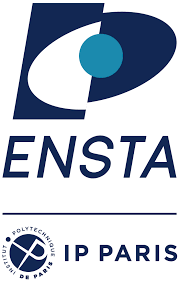



Journée scientifique projet DGA MRIS
Date et Lieu
24 novembre 2016 -- ENSTA ParisTech, Palaiseau
Salle: 1312
Programme
9h00 - Accueil Café
9h30 - Olivier Mullier
Towards a viability kernel computation in higher dimensions with interval analysis
In that work, controlled continuous dynamical systems are considered and they are represented by non-linear systems of ordinary differential equations. From a given closed set , a viable state for is a state such that their exists a control allowing the trajectory from that is solution of to remain in . In this presentation, we focus on the computation of the set of all viable states, namely the viability kernel. The algorithm used to compute this set is an improvement of the one described in Monnet et al. 2015, which is generalized to state-space of dimension greater than two. It is a two step method. Step one is computing an a priori inner approximation of the viability kernel, and step two is focusing on the expansion of the inner approximation. More precisely, step one uses Lyapunov theory to look for regions of the state-space where a linearized version of system is stable, resulting on a set of ellipsoids proved to be included in the viability kernel. Step two makes use of latest improvements on guaranteed integration (guaranteed Runge-Kutta integration methods using interval analysis and affine arithmetic) to enhance the quality of the inner approximation provided by step one. It results on a sub-paving of the viability kernel using boxes.
10h30 - Benjamin Martin
Construction of isolating blocks for dynamical systems
An isolating block is a compact topological structure that can be used to determine the presence of invariants in the region it encloses by solely using conditions on its surface. Considering an algebraic system, checking that a given semi-algebraic set is an isolating block can be done via Sum of Square (SoS) programming and solving (Linear Matrix Inequality) LMI problems which can be done by efficient algorithms. However, generating a semi-algebraic set that is an isolating block is more tedious as the problem involves Bilinear Matrix Inequalities. This talk gives the introductory notions to isolating blocks. By posing the problem as a constraint satisfaction, several generating methods can be investigated, such as SOS with BMI or Quantified Numerical Constraint Satisfaction with interval analysis (with some examples). We also discuss how it relates to other problems such as the generation of barrier functions, and how it can be useful in (controlled) viability problems.
11h30 - Thomas Le Mézo
Lake Guerlédan, an hydrographic and robotic educational project
The exploration and the use of ocean natural resources are a major challenge of 21th century. However, oceans remain largely unexplored even if they represent 71% of the earth’s surface with a mean depth of 4000m. Next generation of engineers will face two strongly linked issues: improve the knowledge of marine environment and allow a sustainable exploitation of available marine resources. These two headline targets are providing new emergent jobs especially in marine and sub-marine robotics and in hydrography or oceanography. In this talk we will present the first edition of the Lake Guerlédan field camp where students from hydrographic and students from robotic background will have to cooperate in order to achieve challenging tasks. At the end of theproject, students will have to build a technology demonstrator that fulfill the maximum possible criteria of challenges. The following points will be presented:
- Educational importance to make robotic and hydrographic community working together.
- Key points to organize the field camp,
- Challenges to solve by the students,
- Further perspectives of development.
12h15 - Khadimoullah Vencatasamy
Building a chain of of underwater robots to secure a chanel
TBA
12h30 - Repas
Club Magnan
14h30 - Luc Jaulin
Construction of a mosaic from an underwater video with guaranteed data associations
In this presentation, I will present a new technique for the construction of a mosaic from an underwater video collected in an underwater environment. The principle is to use proprioceptive data collected by an AUV (here the lock Doppler and the inertial central) in order to detect feasible loops. The procedure consists in six steps.
- Use the proprioceptive sensors only in order to detect all feasible loops.
- Eliminate all pairs of images that do not correspond to loops.
- Associate feasible pairs of images using image processing techniques
- Contract the feasible trajectories by taking into account the image associations.
- Use the trajectory refinement in order to reduce the number of feasible loops.
- If the contractions are significant enough, goto Step 3.
The resulting fixed point technique is shown to converge and to be guaranteed. Some test-cases are presented in order to illustrate the efficiency of the approach.
15h30 - Uli Fahrenberg
Behavioral Specification Theories
Behavioral specification theories are specification formalisms in which specifications have an operational interpretation and models are verified by comparing their operational behavior against the specification's behavior. They come equipped with logical and structural operations which permit compositional and incremental design.
I will give a high-level introduction to behavioral specification theories, followed by specific incarnations and an overview of the state of the art, including the relation between specification theories and contracts. I will finish by an outlook onto how I believe behavioral specification theories can be useful in the rigorous design of cyber-physical systems.
16h30 - Alexandre Chapoutot
Revisting Box-RRT algorithm with DynIBEX
DynIBEX is a library to solve constraint satisfaction problems with differential constraints. This library can solve some quantified constraint satisfaction differential problems (QCSDP). We show through an example of trajectory generation of robots how DynIBEX works.
Social event
19h30 - Pietro Montparnasse
Adresse: 67, boulevard Vaugirard 75015 Paris France